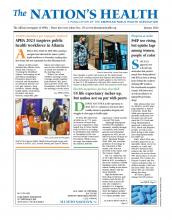
Elan Quashie, a worker with Services for the Under Served, stands with a vending machine that dispenses free fentanyl test strips and naloxone and other health supplies in New York City in June. U.S. life expectancy trails most other nations in part because of drug overdose rates, which have soared in recent years.
Photo by Spencer Platt, courtesy Getty Images
“The CDC report identifies persistent inequities in life expectancy across racialized groups, and an abundance of research points to structural racism as a fundamental driver of these inequities.”
— Jaquelyn Jahn
Despite an uptick in life expectancy in 2022, the U.S. continues to trail most other wealthy nations in population longevity and struggles to close gaps in health equity.
In 2022, life expectancy at birth rose to 77.5 years, an increase of more than one year compared to 2021, largely due to fewer deaths from COVID-19, according to preliminary data released in November by the Centers for Disease Control and Prevention. While a positive sign, the number trails the nation’s 2019 life expectancy, which reached a record 78.8 years.
“Although widespread (COVID-19) population immunity, notably through vaccination, had created genuine and substantial progress by 2022, we are still even worse off than we were,” Elizabeth Wrigley-Field, PhD, MA, associate professor of sociology at the University of Minnesota, who was not involved in the report, told The Nation’s Health.
The U.S. ranked 32 out of 38 in life expectancy at birth in 2021, according to this year’s America’s Health Rankings report, with the nation coming in just above Poland, Mexico and the Slavic Republic.
High mortality rates from drug overdoses, gun violence and chronic illnesses such as heart disease also continue to undercut U.S. longevity. Suicides reached 49,500 in 2022, the highest number ever recorded in the nation. U.S. infant mortality rates continue to outpace most other high-income nations.
“This report underscores how seriously we have moved backward instead of learning from” the pandemic, Wrigley-Field said.

William Lopez, right, hugs Julia Zirimu at a Los Angeles community event in October near posters memorializing people who died by suicide. Suicides reached 49,500 in 2022, the highest number ever recorded, a November CDC report found. A second report highlighted challenges to U.S. life expectancy.
Photo by Allen Schaben, courtesy Getty Images
Life expectancy for American Indian and Alaska Native people was 67.9 years in 2022, higher by over two years compared to the previous year, according to the report from CDC’s National Center for Health Statistics. But that number is lower than any other racial or ethnic group, and 10 years below that of white people. In 2019, the year before the pandemic, life expectancy for American Indian and Alaska Native people was 71.8 years.
Overdose, suicide, chronic illnesses, discrimination and underfunded health services are main drivers of early mortality for American Indian and Alaska Native people, according to Donald Warne, MD, MPH, co-director of the Center for American Indian Health at the Johns Hopkins Bloomberg School of Public Health, who spoke at APHA’s 2023 Annual Meeting and Expo in November.
Type 2 diabetes, once viewed as an adult disease, is now not uncommon among tribal children and adolescents, he said.
In 2022, life expectancy for Hispanic people was 80 years, second only to Asian people, at 84.5 years, the report said. Despite a 2.2-year rise for Hispanics, gains were counterbalanced by rising deaths from influenza and pneumonia, poor nutrition, fetal and infant conditions, kidney disease, and respiratory diseases, suggesting gaps in care.
White people born in 2022 can expect to live 77.5 years, compared to 72.8 years for Black people, whose projected longevity increased by 1.6 years. Fetal and infant mortality is one of the factors holding back more significant increases in life expectancy for Black Americans, whose health continues to suffer from the effects of systemic racism.
An October study in Health Affairs found that states with racial profiling laws and immigration restrictions had the highest early death rates, with profiling having the most impact on Black people.
Researchers found that 29 states, mostly in the South, had multiple harmful laws on the books, such as civic laws requiring identification to vote and an absence of housing protections for domestic violence survivors or those with a felony drug conviction. Many also lack in-state tuition or identification for immigrants who are in the country without legal permission. In those states, premature mortality accounted for 368 per 100,000 deaths.
“The CDC report identifies persistent inequities in life expectancy across racialized groups, and an abundance of research points to structural racism as a fundamental driver of these inequities,” said Jaquelyn Jahn, PhD, MPH, lead author of the Health Affairs study.
The nation’s struggle with its lagging life expectancy numbers also reflects the high number of people of color who suffer an early death at the hands of law enforcement, said Jahn, an assistant professor of epidemiology at Drexel University.
The data reinforces “what activists and communities have been saying for too long — racism kills,” she told The Nation’s Health.
Better policymaking is a must at all levels of government to improve health equity. But compromise will be needed, given the political divisiveness in the U.S. on public health issues, Sandro Galea, MD, dean of Boston University’s School of Public Health, said at APHA 2023.
“Public health is an aspiration rather than a profession,” said Galea, an APHA member. “We aspire for the best of health. How do we get there? It is on us to find the place in the middle, but we have a hard time finding that.”
For more information on the November report, “Provisional Life Expectancy Estimates for 2022,” visit www.cdc.gov/nchs.
- Copyright The Nation’s Health, American Public Health Association









